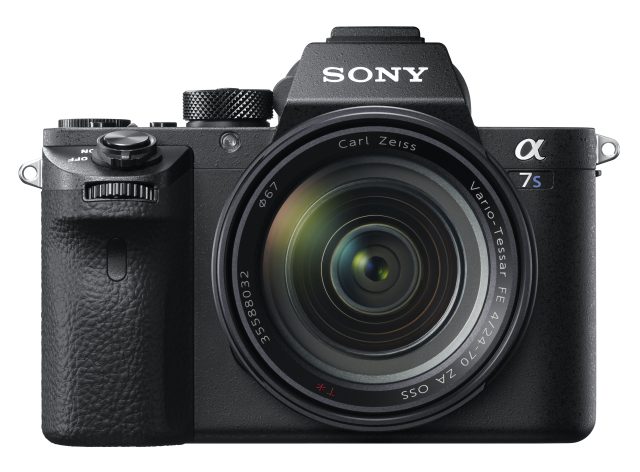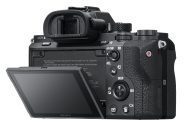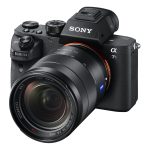Announced
Production status
System
Sony a7S II
35mm AF digital mirrorless camera • Discontinued
Specification
| Format: | |
| 35mm full frame | |
Imaging sensor: | 35.6 × 23.8mm CMOS sensor |
Resolution: | 4240 × 2832 - 12 MP |
Sensor-shift image stabilization: | Yes |
| Sony E [18mm] | |
| Shutter: | |
Type: | Focal-plane |
Model: | Electronically controlled |
Speeds: | 30 - 1/8000 + B |
| Exposure: | |
Exposure metering: | Through-the-lens (TTL), open-aperture |
Exposure modes: | Programmed Auto |
| Aperture-priority Auto | |
| Shutter-priority Auto | |
| Manual | |
| Physical characteristics: | |
Weight: | 627g |
Dimensions: | 126.9x95.7x60.3mm |
Manufacturer description
Sony today announced the latest addition to its award winning series of compact, full-frame α7 cameras with the introduction of the α7S II. Offering ultra-high sensitivity and wide dynamic range across the entire ISO range and 5-axis image stabilisation for greater shooting control, the α7S II delivers stunning image quality for photographers who shoot in the most challenging light conditions. Be it the brightest of mornings or darkest of nights, the α7S II enables new levels of photographic expression at whatever shutter speed you wish to deploy. The α7SII also incorporates a host of pro-style movie functions including the ability to shoot 4K video with full pixel readout and no pixel binning in full-frame format, making it an extremely appealing proposition for photographers and videographers alike.
The α7S II delivers an awe-inspiring sensitivity range of ISO 50-409600[i], thanks to the combination of its 35mm full-frame 12.2 megapixel[ii] image sensor and BIONZ X image processing engine. The sensor optimises the dynamic range across the entire ISO range and broadens the range of tonal gradation in bright environments and minimises noise in dark scenes meaning that it delivers impressive results even in the most extreme conditions. The upgraded image processing algorithm of BIONZ X maximises the sensor’s capabilities and improves depiction throughout the full sensitivity range with particular emphasis on the mid-to-high range. This means that the resulting stills and movies demonstrate extra-fine detail with minimal noise.
Video Master
The α7S II can record 4K[iii] movies internally in the XAVC S format[iv] meaning that content is wonderfully detailed. Because information from all pixels is utilised without line skipping or pixel binning, the camera can maximise the expanded power of the full-frame image sensor and produce 4K movies with higher image clarity and negligible moiré. Full pixel readout without pixel binning is also employed when shooting Full HD[v] movies which means that it collects information from approximately five times as many pixels that are required to generate Full HD[vi] and condenses the information to produce extremely high quality movies.
In a first for the α7 series, the α7S II can record 120fps at 100Mbps[vii] with full pixel readout without pixel binning in full frame format which can be edited into wonderful 4x/5x slow motion footage[viii] in Full HD. The α7S II also has the ability to shoot 4x/5x slow motion footage internally which can be immediately reviewed on the camera screen.
Video functionality has been further enhanced with new profiles; S-Gamut3.Cine/S-Log3 and S-Gamut3/S-Log3. These new profiles deliver wide dynamic range and colour correction is easier to perform. The α7S ll even offers impressive 14-stop latitude in the S-Log3 gamma setting. The camera also supports S-Gamut/S-Log2 which is very popular among cinematographers and videographers. Gamma Display Assist is a new function that allows users to monitor images or check focus when recording S-Log movies and the Zebra function has been improved for even greater control.
5-Axis Image Stabilisation
The new α7S II is equipped with the innovative 5-axis image stabilisation system that is proving extremely popular in the α7 II and α7R II cameras. The system corrects camera shake along five axes during shooting, including angular shake (pitch and yaw) which has the greatest impact on image quality and tends to occur with a telephoto lens, shift shake (X and Y axes) which becomes noticeable as magnification increases, and rotational shake (roll) that often affects night shooting or video recording.
Autofocus accuracy
The autofocus system on the α7S II has been upgraded and now offers 169 AF points for fast, precise focusing with greater accuracy.[ix] The power of the image sensor means that the absence of noise in images generated, enables the Fast Intelligent AF to detect contrast more easily and react speedily even in low-light situations (as low as EV-4), when it’s even tough to check with the naked eye. When shooting video, the AF performance is twice as fast as the predecessor model.[x]
Electronic Viewfinder
The XGA OLED Tru-Finder in the α7S II has been upgraded and offers the world’s highest viewfinder magnification[xi] of 0.78x (roughly 38.5 degrees in diagonal field of view) and shows clear images across the entire display area. The use of ZEISS T* Coating ensures sharp reduction of reflections on the viewfinder and unlike an optical viewfinder, the OLED Tru-Finder can be used to instantly show how exposure compensation, white balance and other selected settings are affecting the displayed image.
User upgrades
A number of enhancements have been made to the look and feel of the α7S II to make it more user friendly, reliable and intuitive. Its magnesium-alloy body is both light and highly robust and the grip and shutter buttons have been re-designed so that the camera feels more natural in the hand. For situations when you just want to blend into the background, silent shooting mode can be activated for 5fps continuous shooting[xii] and reliability has been enhanced with reduced-vibration shutter movement.[xiii] The lens mount has been further reinforced to ensure greater resilience, particularly when attaching third party lenses and users can now charge the camera via a USB power supply whilst the camera is in operation, thus extending battery life. For greater comfort and safety, Sony is also launching the LCS-EBF; a new premium leather body case for the α7S II which is also compatible with the α7R II and α7 II.
The α7S II is also Wi-Fi® and NFC compatible and fully functional with Sony’s PlayMemories Mobile application available for Android™ and iOS™ platforms, as well as Sony’s growing range of PlayMemories Camera Apps, which add a range of fun creative capabilities to the camera.




